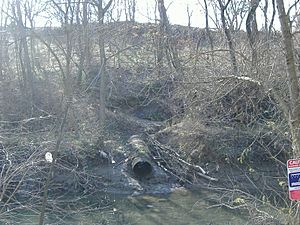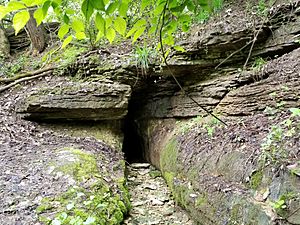Eleven Jones Cave facts for kids
Eleven Jones Cave is a cool cave located right by Beargrass Creek in Louisville, Kentucky. It's about 1,600 feet (488 m) southeast of the corner of Eastern Parkway and Poplar Level Road. You can find it on the west side of the creek, between Louisville Cemetery and Calvary Cemetery, not far from St. Xavier High School. The cave formed in Limestone rock and sits about 448 feet (137 m) above sea level. A natural spring flows out of the cave, sending water into Beargrass Creek.
This cave is the most famous and well-studied cave in Jefferson County. Many people say it got its name because eleven brothers named Jones supposedly used it. However, some think it was actually named after early residents Levin Powell and John Jones. The cave is also super important because it's the only known home for a special insect called the Louisville cave beetle.
The entrance to the cave is a stoopway, meaning you have to bend down to get in. It's about 4.5 feet (1.4 m) high and 2.5 feet (0.8 m) wide. This leads into a 40-foot (12 m) passage.
The Legend of Eleven Jones Cave
There's a popular story about Eleven Jones Cave. People say that a group of people named Jones used the cave as a secret hideout back in the 1800s. The legend claims they hid valuable items they had taken inside the cave. It's also said that these brothers created eleven secret rooms within the cave where they lived!
Eventually, the Jones group supposedly left the area. The legend says their hidden treasure is still there, behind collapsed rocks. Since no one has ever found these eleven rooms, the story goes that the group sealed them off by making the cave roof collapse. Another part of the legend claims the cave was once big enough to drive a horse and carriage through. But geologists say this isn't possible, as caves don't "shrink" in that way.
Some versions of the story even mention strong metal bars on a gate inside the cave. These bars were supposedly there to stop anyone from finding the Jones's gold, silver, and jewels. The legend also says a cannon guarded a main passage! However, a book from the University of Kentucky Press has called these stories "mythical," meaning they are just legends.
Early writings about the area, even as late as 1822, don't mention the cave or its legends. But by 1831, local people knew about it as the source of a spring. The name "Eleven Jones Cave" first appeared in 1848. People used to say there were eight entrances to the cave along Beargrass Creek, but only the main spring entrance has ever been found.
Cave Studies and Discoveries
Scientists and explorers have studied Eleven Jones Cave. In 1967, two teams explored the cave. They didn't find any proof of the Jones Brothers' story. They also didn't find any evidence for another story that an army saber (a type of sword) from the American Civil War was found in the cave in 1949. The studies confirmed that the only entrance was the spring entrance on Beargrass Creek.
One important discovery is that the air inside the cave can be dangerous. There are very high levels of carbon dioxide (CO2) just inside the entrance. This can cause a lack of oxygen (hypoxia) very quickly, and it can be fatal deeper inside the cave. The CO2 levels are more than 10 times higher than normal air!
The cave is also the only known place where the Louisville cave beetle, called Pseudanophthalmus troglodytes, lives. This tiny insect is reddish-brown, has no eyes, and eats other small invertebrates. The Louisville cave beetle was first described in 1973 from specimens found in another cave nearby. In 1994, surveys looked for this beetle in other caves, but it was only found in Eleven Jones Cave. This makes the cave very important for protecting this unique species.
In Popular Culture
Eleven Jones Cave has even appeared in a story! A character in a book called 17776 hides in Eleven Jones Cave. In the story, the character even talks directly to the reader, warning them not to visit the cave.



